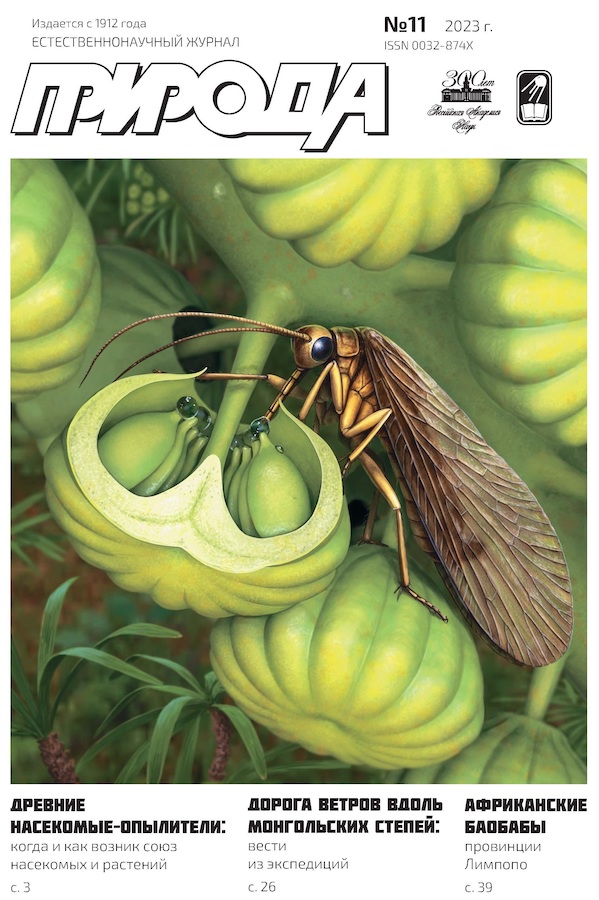Ancient Pollinating Insects
- Авторлар: Khramov A.V1
-
Мекемелер:
- Borissiak Paleontological Institute, Russian Academy of Sciences
- Шығарылым: № 11 (2023)
- Беттер: 3-12
- Бөлім: Articles
- URL: https://journals.eco-vector.com/0032-874X/article/view/627859
- DOI: https://doi.org/10.7868/S0032874X23110017
- ID: 627859
Дәйексөз келтіру
Аннотация
Recent studies of the mouthparts of fossil insects and the pollen preserved on their bodies and in their guts have shed new light on the evolution of insect pollination. In particular, it has been shown that various groups of gymnosperms could have used insects as pollinating agents long before the appearance of flowering plants. The paper provides an overview of the most important studies in paleoentomology, which focused on the origin and evolution of mutualistic relationships between plants and insect pollinators.
Негізгі сөздер
Авторлар туралы
A. Khramov
Borissiak Paleontological Institute, Russian Academy of Sciences
Email: a-hramov@yandex.ru
Moscow, Russia
Әдебиет тізімі
- Ollerton J., Winfree R., Tarrant S. How many flowering plants are pollinated by animals? Oikos. 2011; 120: 321–326.
- Ramírez S., Gravendeel B., Singer R. B. et al. Dating the origin of the Orchidaceae from a fossil orchid with its pollinator. Nature. 2007; 448: 1042–1045.
- Khramov A. V., Naugolnykh S. V., Węgierek P. Possible long-proboscid insect pollinators from the Early Permian of Russia. Current Biology. 2022; 32: 3815–3820.e2.
- Khramov A. V., Nam G.-S., Vasilenko D. V. First long-proboscid flies (Diptera: Zhangsolvidae) from the Lower Cretaceous of South Korea. Alcheringa: An Australasian Journal of Palaeontology. 2020; 44: 160–168.
- Khramov A. V., Lukashevich E. D. A Jurassic dipteran pollinator with an extremely long proboscis. Gondwana Research. 2019; 71: 210–215.
- Khramov A. V., Bashkuev A. S., Lukashevich E. D. The fossil record of long-proboscid nectarivorous insects. Entomological Review. 2020; 100: 881–968.
- Khramov A. V., Yan E., Kopylov D. S. Nature’s failed experiment: Long-proboscid Neuroptera (Sisyridae: Paradoxosisyrinae) from Upper Cretaceous amber of northern Myanmar. Cretaceous Research. 2019; 104: 104180.
- Krasilov V. A., Rasnitsyn A. P., Afonin S. A. Pollen eaters and pollen morphology: co-evolution through the Permian and Mesozoic. African Invertebrates. 2007; 48: 3–11.
- Khramov A. V., Foraponova T., Węgierek P. The earliest pollen-loaded insects from the Lower Permian of Russia. Biology Letters. 2023; 19: 20220523.
- Krasilov V. A., Rasnitsyn A. P. A unique finding: pollen in the intestine of Early Cretaceous sawflies. Paleontological Journal. 1982; 16: 80–94.
- Krasilov V. A., Zherikhin V. V., Rasnitsyn A. P. Classopollis in the guts of Jurassic insects. Palaeontology. 1997; 40: 1095–1101.
- Peñalver E., Labandeira C. C., Barrón E. et al. Thrips pollination of Mesozoic gymnosperms. Proceedings of the National Academy of Sciences. 2012; 109: 8623–8628.
- Peñalver E., Arillo A., Pérez-de la Fuente R. et al. Long-proboscid flies as pollinators of Cretaceous gymnosperms. Current Biology. 2015; 25: 1917–1923.
- Peris D., Pérez-de la Fuente R., Peñalver E. et al. False blister beetles and the expansion of gymnosperm-insect pollination modes before angiosperm dominance. Current Biology. 2017; 27: 897–904.
- Huang D., Bechly G., Nel P. et al. New fossil insect order Permopsocida elucidates major radiation and evolution of suction feeding in hemimetabolous insects (Hexapoda: Acercaria). Scientific Reports. 2016; 6: 23004.
- Bao T., Wang B., Li J., Dilcher D. Pollination of Cretaceous flowers. Proceedings of the National Academy of Sciences. 2019; 116: 24707–24711.
- Grimaldi D. A., Peñalver E., Barrón E. et al. Direct evidence for eudicot pollen-feeding in a Cretaceous stinging wasp (Angiospermae; Hymenoptera, Aculeata) preserved in Burmese amber. Communications Biology. 2019; 2: 408.
- Cai С., Escalona H. E., Li L. et al. Beetle pollination of cycads in the Mesozoic. Current Biology. 2018; 28: 2806–2812.e1.
- Wappler T., Labandeira C. C., Engel M.S. et al. Specialized and generalized pollen-collection strategies in an ancient bee lineage. Current Biology. 2015; 25: 3092–3098.
- Geier C., Bouchal J. M., Ulrich S. et al. Potential pollinators and paleoecological aspects of Eocene Ludwigia (Onagraceae) from Eckfeld, Germany. Palaeoworld. 2023. doi: 10.1016/j.palwor.2023.07.003.
- Compton S. G., Ball A. D., Collinson M. E. et al. Ancient fig wasps indicate at least 34 Myr of stasis in their mutualism with fig trees. Biology Letters. 2010; 6: 838–842.
- Wedmann S., Hörnschemeyer T., Engel M. S. et al. The last meal of an Eocene pollen-feeding fly. Current Biology. 2021; 31: 2020–2026.e4.
Қосымша файлдар








